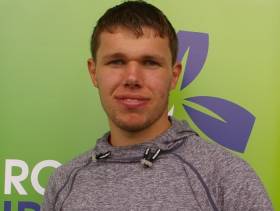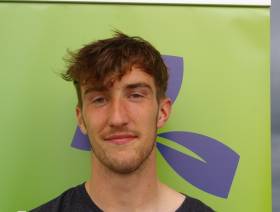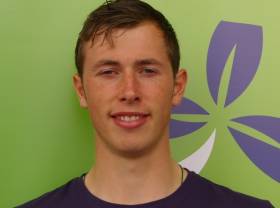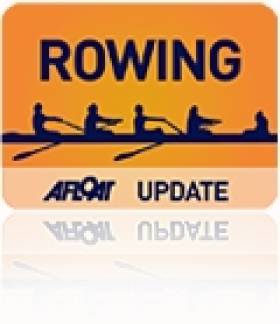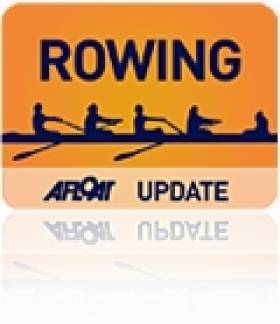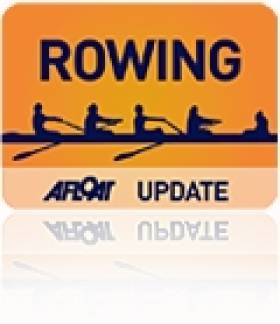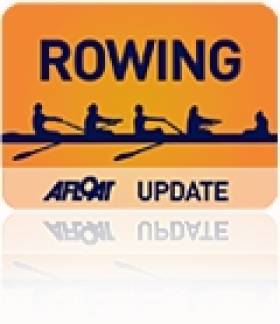Displaying items by tag: Quadruple
Sixth For Ireland Quad after False Start at World Rowing
#Rowing: Ireland finished sixth in the B Final of the under-23 quadruple at the World Rowing Championships in Rotterdam today. The Irish made a false start and held sixth down the course, though they never lost touch with the rest of the crews in the fierce heat. The race for top spot, and seventh in the world, was an enthralling one: Russia and France jousted, with the Russians finishing very well to win.
World Rowing Championships, Rotterdam (Irish interest; selected results)
Men
Under-23 Quadruple Sculls - B Final (Places 7 to 12): 1 Russia 5:54.0; 6 Ireland (D Buckley, J Casey, P Boomer, S McKeown) 6:01.78.
Fine Finish Sees Ireland Into Second World Rowing A Final
#Rowing: Ireland’s under-23 lightweight quadruple joined the under-23 lightweight pair at the A Final stage of the Under-23 World Championships in Rotterdam. The crew of Fintan McCarthy, Shane O’Connell, Stephen O’Connor and stroke Colm Hennessy finished second to Britain in a fine semi-final. Ireland and Sweden held the qualifying places behind Britain for a good part of the course, but New Zealand mounted an attack in the final third. Ireland upped their rate and held out for second, with Sweden also moving into the A Final.
The under-23 heavyweight quadruple finished fifth in their semi-final. The race was won by Australia, with New Zealand and Britain booking their A Final places by taking second and third. Ireland fought with Ukraine to avoid last and held out at the end to win this battle.
World Rowing Championships, Rotterdam (Irish interest; selected results)
Men
Under-23 Lightweight Pair - Semi-Finals (First Three to A Final; rest to B Final) - Semi-Final One: 1 Greece 6:39.18, 2 Switzerland 6:40.01, 3 China 6:44.52. Semi-Final Two: 1 Ireland (S Mulvaney, D O’Malley) 6:46.20, 2 Turkey 6:49.11, 3 United States 6:50.75.
Under-23 Quadruple - Semi-Finals (First Three to A Final; rest to B Final) - Semi-Final One: 1 Poland 5:51.05, 2 Italy 5:52.38, 3 Germany 5:52.53. Semi-Final Two: 1 Australia 5:54.34, 2 New Zealand 5:56.53, 3 Britain 5:56.93; 5 Ireland (D Buckley, J Casey, P Boomer, S McKeown) 6:12.94.
Under-23 Lightweight Quadruple - Semi-Finals (First Three to A Final; rest to B Final) - Semi-Final One: 1 Italy 6:07.44, 2 Canada 6:09.42, 3 Germany 6:10.05. Semi-Final Two: 1 Britain 6:06.01, 2 Ireland (F McCarthy, S O'Connell, S O'Connor, C Hennessy) 6:07.18, 3 Sweden 6:07.28.
Ireland Quadruple Makes World Rowing Semi-Finals
#Rowing: Ireland’s under-23 heavyweight quadruple qualified for the semi-finals at the World Rowing Championships in Rotterdam today. The crew of Daniel Buckley, Jack Casey, Patrick Boomer and Sam McKeown took the third qualification place behind Britain and Russia in their repechage. They join the Ireland under-23 lightweight pair and lightweight quadruple, which qualified from their heats.
World Rowing Championships, Rotterdam (Selected Results; Irish interest)
Men
Under-23 Quadruple - Repechage One (Three to A/B Semi-Finals; rest to C Final): 1 Britain 5:54.05, 2 Russia 5:56.18, 3 Ireland (D Buckley, J Casey, P Boomer, S McKeown) 5:57.67.
Ireland Quadruple Set for Repechages at World Rowing
#Rowing: Ireland's under-23 heavyweight quadruple finished fifth in their heat at the World Championships in Rotterdam and must compete in a repechage to find their way into the A/B semi-finals. The crew of Daniel Buckley, Jack Casey, Patrick Boomer and Sam McKeown needed to finish in the top two to qualify directly. Australia had the confidence and speed to take the lead early and go on to win; Britain and Italy fought it out for the crucial second place, with the Italians taking it. Ireland were fourth down the course but were passed by Norway in the final quarter.
World Rowing Championships, Rotterdam (Selected Results; Irish interest)
Men
Under-23 Lightweight Pair - Heat Two (First Three to A/B Semi-Final; rest to Repechages): 1 Turkey 6:39.80, 2 Greece 6:40.70, 3 Ireland (S Mulvaney, D O’Malley) 6:45.09.
Under-23 Quadruple - Heat Three (First two A/B Semi-Final; rest to Repechages) 1 Australia 5:52.01, 2 Italy 5:53.31; 5 Ireland (D Buckley, J Casey, P Boomer, S McKeown) 6:15.47.
#ROWING: The Ireland quadruple finished second in their B Final, eighth overall, at the European Junior Championships at Racice in the Czech Republic today. The Ireland crew of Colm Henessey, Eoghan Whittle, Patrick Munnelly and Andrew Goff had finished sixth in the A/B semi-final. The double of Shane O’Connell and Ronan Byrne were fourth in their C Final, 16th overall.
European Junior Rowing Championships, Racice, Czech Republic (Irish interest):
Men
Quadruple Sculls – A/B Semi-Final One: 6 Ireland (A Goff, P Munnelly, E Whittle, C Hennessy) 6:30.35. B Final (Places 7 to 12): 2 Ireland 6:23.993.
Double Sculls – C Final (Places 13 to 18): 4 Ireland (S O’Connell, R Byrne) 7:16.086.
Fourth for Ireland Quadruple at World Rowing Championships
Ireland had two A Finalists at the World Rowing Championships in Bled in Slovenia this morning. The men’s lightweight quadruple scull of Niall Kenny, Michael Maher, Justin Ryan and Mark O’Donovan finished fourth, with Denmark pipping them for the bronze medal The Adaptive coxed four were one place further back. Even in a much stronger event this year, Anne-Marie McDaid, Sarah Caffrey, Shane Ryan and Kevin du Toit and cox Helen Arbuthnot matched their performance of last year in placing fifth in the world in the Legs, Trunk and Arms mixed coxed four.
The programme for the day was brought forward because of forecast bad weather.
World Rowing Championships, Bled, Slovenia – Day Eight (Selected Results; Afloat)
Men
Four – A Final: 1 Britain 5:55.18, 2 Greece 5:57.20, 3 Australia 5:58.44.
Lightweight Eight – A Final: 1 Australia 5:44.57, 2 Italy 5:44.73, 3 Denmark 5:46.75.
Lightweight Quadruple Scull – A Final: 1 Italy 6:00.95, 2 Germany 6:01.08, 3 Denmark 6:02.81; 4 Ireland (N Kenny, M Maher, J Ryan, M O’Donovan) 6:03.84, 5 United States 6:09.40, 6 Hungary 6:20.07.
Lightweight Double Sculls – A Final: 1 Britain 6:18.67, 2 New Zealand 6:19.01, 3 Italy 6:21.33.
Women
Lightweight Double Sculls – A Final: 1 Greece 6:59.80, 2 Canada 7:03.46, 3 Britain 7:04.33.
Single Sculls – A Final: 1 Czech Republic (M Knapkova) 7:26.64, 2 Belarus (E Karsten) 7:28.68, 3 New Zealand (E Twigg) 7:30.68.
Adaptive
Legs, Trunk and Arms mixed coxed Four (1,000m) – A Final: 1 Britain 3:27.10, 2 Canada 3:31.84, 3 Germany 3:33.27; 4 France 3:37.17, 5 Ireland (A-M McDaid, S Caffrey, S Ryan, K du Toit; cox: H Arbuthnot) 3:38.13, 6 United States 3:38.16.
Quadruple Misses Out on Semi-Final in Amsterdam
Ireland’s men’s lightweight quadruple scull failed to join the two women’s crews in the semi-finals of the World Under-23 Rowing Championships in Amsterdam. The crew of Shane O’Driscoll, Niall Kenny, Peter Hanily and Justin Ryan could only finish fifth in their repechage, where the top three qualified. Denmark and Switzerland headed the field, with Poland finishing well to take third. Britain were fourth and are set for the B Final alongside Ireland.
Lightweight single sculler Jonathan Mitchell finished third in his C/D semi-final and qualified for the C Final (places 13 to 18).
World Under-23 Rowing Championships, Day Three (Irish interest)
Men
Lightweight Quadruple Scull – Repechage Two (First Three to A/B Semi-Finals; rest to B Final): 1 Denmark 5:54.81, 2 Switzerland 5:56.16, 3 Poland 5:57.97; 4 Britain 6:00.23, 5 Ireland (S O’Driscoll, N Kenny, P Hanily, J Ryan) 6:04.17, 6 Austria 6:08.25.
Lightweight Single Scull – Quarter Final Four: 1 United States (A Campbell Jr) 7:11.51, 2 Greece (P Magdanis) 7:14.64, 3 Peru (R Leon Garcia) 7:20.45; 4 Ireland (J Mitchell) 7:33.62, 5 Iraq 7:40.79, 6 Armenia 8:00.14. C/D Semi-Final (First Three to C Final): 1 Chile 7:18.31, 2 Sweden 7:19.38, 3 Ireland (Mitchell) 7:19.99.
Women
Lightweight Double Scull – Repechage (First Three to A/B Semi-Finals): 1 Ireland (S Dolan, C Lambe) 7:24.04, 2 Romania 7:24.63, 3 Italy 7:26.92; 4 Czech Republic 7:35.46, 5 Tunisia 8:00.09.
Single Scull – Repechage (First Three to A/B Semi-Finals): 1 The Netherlands (N Beukers) 7:45.46, 2 Ireland (L Dilleen) 7:45.81, 3 Greece (A Nikolaidou) 7:52.71; 4 Latvia 8:06.32, 5 USA 8:11.64.
Cork Crews Rise to the Top at Cork Head
Cork crews saw off rivals from far and near at the Cork rowing Head of the River at the Marina on Saturday. UCC’s men’s senior eight were the fastest men’s crew – by 1.3 seconds from De Maas of Rotterdam, a masters eight. The fastest women’s crew was Cork Boat Club’s junior 18 eight, adjudged just .8 of a second quicker than UCD’s women’s senior eight. The fastest men’s single sculler was John Keohane of Lee Valley and Karen Corcoran-O’Hare of Shandon was the fastest women’s single sculler.
Cork Head of the River, The Marina, Cork, Saturday
Overall: 1 UCC men’s senior eight 12 minutes 6.7 seconds, 2 De Maas, Rotterdam men’s masters eight 12:08.0, 3 UCC men’s novice eight 12:25.9, 4 UCD men’s novice eight 12:42.4, 5 Presentation College men’s junior eight 12:44.3, 6 Muckross intermediate eight 12:49.9.
Men, Eight – Senior: UCC 12:06.7. Intermediate: Muckross 12:49.9. Novice: UCC 12:25.9. Junior: Presentation 12:44.3. Junior 16: Cork 13:21.2. Masters: De Maas 12:08.0.
Fours – Senior: Cork/Garda 12:53.6. Intermediate: UCC 13:40.6. Novice: Cappoquin 13:43.9. Junior 18, coxed: Presentation 13:04.0
Pair – Junior 18: Presentation 14:58.7. Masters: De Maas 13:09.9. Coastal – Novice: Ahakista 17:28.7.
Sculling, Quadruple – Senior: Shannon 13:50.8. Novice: Shannon 15:07.4. Junior 18: Cork 13:05.3. Junior 16: Cork 13:15.2.
Double – Intermediate: Cork IT 13:41.6. Junior 18: Clonmel 13:53.9. Junior 16: St Michael’s 15:04.4. Coastal – Novice: Kilmacsimon 16:17.2.
Single – Senior: Lee Valley (J Keohane) 14:16.4. Intermediate: Lee (O’Connell) 14:53.4. Novice: Lee (O’Connell) 14:37.9. Junior 18: Workmen’s (Burns) 14:33.0. Junior 16: Shandon (Casey) 15:08.9. Masters: Skibbereen (Barry) 15:40.07. Coastal – Novice: Kilmacsimon 17:33.6
Women – Overall: 1 Cork junior eight 13:40.0, 2 UCD senior eight 13:40.8, 3 St Michael’s junior eight 13:54.1.
Eight – Senior: UCD 13:40.8. Novice: UCC 14:25.4. Junior 18: 1 Cork 13:40.0. Junior 16: Clonmel 16:21.0.
Four – Senior: Muckross 14:15.9. Intermediate: UCC 17:00.9. Novice: UCC 16:29.8. Masters: Skibbereen 22:34.9.
Pair – Junior 18: St Michael’s 15:00.2.
Sculling, Quadruple - Novice: Shannon 15:51.4. Junior 16: St Michael’s 15:16.5.
Double – Intermediate: UCC 16:15.1. Junior 18: Cork 14:43.9. Junior 16: Lee 15:42.3. Masters: Cork 15:38.3.
Single – Senior: Intermediate: Shandon (K Corcoran-O’Hare) 15:39.7. Junior 18: Lee (Kearney) 16:52.1. Junior 16: Lee (Hamel) 16:13.6. Masters: Cork (Crowley) 17:49.2.
Coastal: 1 Kilmacsimon men’s novice double scull 16:17.2, 2 Ahakista men’s novice quadruple coxed scull 17:28.7.
Click this link for Irish Rowing detailsClick this link for the Latest Rowing News


























